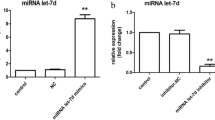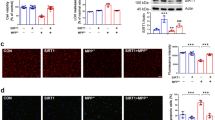Abstract
The aberrant expression of Forkhead box M1 (FOXM1) has been associated with the pathological processes of Parkinson’s disease (PD), but the upstream and downstream regulators remain poorly understood. This study sought to examine the underlying mechanism of FOXM1 in dopaminergic neuron injury in PD. Bioinformatics analysis was conducted to pinpoint the differential expression of FOXM1, which was verified in the nigral tissues of rotenone-lesioned mice and dopaminergic neuron MN9D cells. Interactions among SP1, FOXM1, SNAI2, and CXCL12 were analyzed. To evaluate their effects on dopaminergic neuron injury, the lentiviral vector-mediated manipulation of FOXM1, SP1, and CXCL12 was introduced in rotenone-lesioned mice and MN9D cells. SP1, FOXM1, SNAI2, and CXCL12 abundant expression occurred in rotenone-lesioned mice and MN9D cells. Silencing of FOXM1 delayed the rotenone-induced dopaminergic neuron injury in vitro. Mechanistically, SP1 was an upstream transcription factor of FOXM1 and upregulated FOXM1 expression, leading to increased SNAI2 and CXCL12 expression. In vivo, data confirmed that SP1 promoted dopaminergic neuron injury by activating the FOXM1/SNAI2/CXCL12 axis. Our data indicate that SP1 silencing has neuroprotective effects on dopaminergic neurons, which is dependent upon the inactivated FOXM1/SNAI2/CXCL12 axis.







Similar content being viewed by others
Data Availability
The data supporting this study’s findings are available on request from the corresponding author.
References
Smajic S, Prada-Medina CA, Landoulsi Z et al (2022) Single-cell sequencing of human midbrain reveals glial activation and a Parkinson-specific neuronal state. Brain 145(3):964–978. https://doi.org/10.1093/brain/awab446
Wang ZL, Yuan L, Li W, Li JY (2022) Ferroptosis in Parkinson’s disease: glia-neuron crosstalk. Trends Mol Med 28(4):258–269. https://doi.org/10.1016/j.molmed.2022.02.003
Tan EK, Chao YX, West A, Chan LL, Poewe W, Jankovic J (2020) Parkinson disease and the immune system - associations, mechanisms and therapeutics. Nat Rev Neurol 16(6):303–318. https://doi.org/10.1038/s41582-020-0344-4
Ho MS (2019) Microglia in Parkinson’s Disease. Adv Exp Med Biol 1175:335–353. https://doi.org/10.1007/978-981-13-9913-8_13
Piancone F, La Rosa F, Marventano I, Saresella M, Clerici M (2021) The role of the inflammasome in neurodegenerative diseases. Molecules 26(4):953. https://doi.org/10.3390/molecules26040953
Levesque S, Wilson B, Gregoria V et al (2010) Reactive microgliosis: extracellular micro-calpain and microglia-mediated dopaminergic neurotoxicity. Brain 133(Pt 3):808–821. https://doi.org/10.1093/brain/awp333
Ros-Bernal F, Hunot S, Herrero MT et al (2011) Microglial glucocorticoid receptors play a pivotal role in regulating dopaminergic neurodegeneration in parkinsonism. Proc Natl Acad Sci U S A 108(16):6632–6637. https://doi.org/10.1073/pnas.1017820108
Littler DR, Alvarez-Fernandez M, Stein A et al (2010) Structure of the FoxM1 DNA-recognition domain bound to a promoter sequence. Nucleic Acids Res 38(13):4527–4538. https://doi.org/10.1093/nar/gkq194
Kalathil D, John S, Nair AS (2020) FOXM1 and cancer: faulty cellular signaling derails homeostasis. Front Oncol 10:626836. https://doi.org/10.3389/fonc.2020.626836
Rather TB, Parveiz I, Bhat GA et al (2022) Evaluation of Forkhead box M1 (FOXM1) gene expression in colorectal cancer. Clin Exp Med. https://doi.org/10.1007/s10238-022-00929-7
Li Y, Wu F, Tan Q et al (2019) The multifaceted roles of FOXM1 in pulmonary disease. Cell Commun Signal 17(1):35. https://doi.org/10.1186/s12964-019-0347-1
Yu W, Wang G, Li LX et al (2023) Transcription factor FoxM1 promotes cyst growth in PKD1 mutant ADPKD. Hum Mol Genet 32(7):1114–1126. https://doi.org/10.1093/hmg/ddac273
Yu F, Le ZS, Chen LH, Qian H, Yu B, Chen WH (2020) Identification of biomolecular information in rotenone-induced cellular model of Parkinson’s disease by public microarray data analysis. J Comput Biol 27(6):888–903. https://doi.org/10.1089/cmb.2019.0151
Tabatabaei Dakhili SA, Perez DJ, Gopal K et al (2021) SP1-independent inhibition of FOXM1 by modified thiazolidinediones. Eur J Med Chem 209:112902. https://doi.org/10.1016/j.ejmech.2020.112902
Yao L, Dai X, Sun Y et al (2018) Inhibition of transcription factor SP1 produces neuroprotective effects through decreasing MAO B activity in MPTP/MPP(+) Parkinson’s disease models. J Neurosci Res 96(10):1663–1676. https://doi.org/10.1002/jnr.24266
Cai Y, Zhang MM, Wang M, Jiang ZH, Tan ZG (2022) Bone marrow-derived mesenchymal stem cell-derived exosomes containing Gli1 alleviate microglial activation and neuronal apoptosis in vitro and in a mouse Parkinson disease model by direct inhibition of Sp1 signaling. J Neuropathol Exp Neurol 81(7):522–534. https://doi.org/10.1093/jnen/nlac037
Cai LJ, Tu L, Li T et al (2020) Up-regulation of microRNA-375 ameliorates the damage of dopaminergic neurons, reduces oxidative stress and inflammation in Parkinson’s disease by inhibiting SP1. Aging (Albany NY) 12(1):672–689. https://doi.org/10.18632/aging.102649
Qiu Y, Cao X, Liu L et al (2020) Modulation of MnSOD and FoxM1 is involved in invasion and EMT Suppression by Isovitexin in Hepatocellular Carcinoma Cells. Cancer Manag Res 12:5759–5771. https://doi.org/10.2147/CMAR.S245283
Zhou W, Gross KM, Kuperwasser C (2019) Molecular regulation of Snai2 in development and disease. J Cell Sci. 132(23):jcs.235127. https://doi.org/10.1242/jcs.235127
Wu Z, Ding H, Chen Y et al (2023) Motor neurons transplantation alleviates neurofibrogenesis during chronic degeneration by reversibly regulating Schwann cells epithelial-mesenchymal transition. Exp Neurol 359:114272. https://doi.org/10.1016/j.expneurol.2022.114272
Horiguchi K, Fujiwara K, Tsukada T et al (2016) Expression of Slug in S100beta-protein-positive cells of postnatal develo** rat anterior pituitary gland. Cell Tissue Res 363(2):513–524. https://doi.org/10.1007/s00441-015-2256-y
Wang H, Wang X, Zhang Y, Zhao J (2021) LncRNA SNHG1 promotes neuronal injury in Parkinson’s disease cell model by miR-181a-5p/CXCL12 axis. J Mol Histol 52(2):153–163. https://doi.org/10.1007/s10735-020-09931-3
Zhou Q, Chen B, Xu Y et al (2023) Geniposide protects against neurotoxicity in mouse models of rotenone-induced Parkinson’s disease involving the mTOR and Nrf2 pathways. J Ethnopharmacol 318(Pt A):116914. https://doi.org/10.1016/j.jep.2023.116914
Inden M, Kitamura Y, Abe M, Tamaki A, Takata K, Taniguchi T (2011) Parkinsonian rotenone mouse model: reevaluation of long-term administration of rotenone in C57BL/6 mice. Biol Pharm Bull 34(1):92–96. https://doi.org/10.1248/bpb.34.92
Yu Z, Zhang T, Gong C et al (2016) Erianin inhibits high glucose-induced retinal angiogenesis via blocking ERK1/2-regulated HIF-1alpha-VEGF/VEGFR2 signaling pathway. Sci Rep 6:34306. https://doi.org/10.1038/srep34306
Zhao R, Yan Q, Huang H, Lv J, Ma W (2013) Transdermal siRNA-TGFbeta1-337 patch for hypertrophic scar treatment. Matrix Biol 32(5):265–276. https://doi.org/10.1016/j.matbio.2013.02.004
Kamei J, Matsunawa Y, Miyata S, Tanaka S, Saitoh A (2004) Effects of nociceptin on the exploratory behavior of mice in the hole-board test. Eur J Pharmacol 489(1–2):77–87. https://doi.org/10.1016/j.ejphar.2003.12.020
Ma Y, Rong Q (2022) Effect of Different MPTP administration intervals on mouse models of Parkinson’s disease. Contrast Media Mol Imaging 2022:2112146. https://doi.org/10.1155/2022/2112146
Deng X, Guo B, Fan Y (2021) MiR-153–3p suppresses cell proliferation, invasion and glycolysis of thyroid cancer through inhibiting E3F3 expression. Onco Targets Ther 14:519–529. https://doi.org/10.2147/OTT.S267887
Jensen EC (2013) Quantitative analysis of histological staining and fluorescence using ImageJ. Anat Rec (Hoboken) 296(3):378–381. https://doi.org/10.1002/ar.22641
Rodemerk J, Oppong MD, Junker A et al (2022) Ischemia-induced inflammation in arteriovenous malformations. Neurosurg Focus 53(1):E3. https://doi.org/10.3171/2022.4.FOCUS2210
Zhu M, Liu X, Wang Y et al (2018) YAP via interacting with STAT3 regulates VEGF-induced angiogenesis in human retinal microvascular endothelial cells. Exp Cell Res 373(1–2):155–163. https://doi.org/10.1016/j.yexcr.2018.10.007
Guhathakurta S, Kim J, Adams L et al (2021) Targeted attenuation of elevated histone marks at SNCA alleviates alpha-synuclein in Parkinson’s disease. EMBO Mol Med 13(2):e12188
Huan J, Hornick NI, Shurtleff MJ et al (2013) RNA trafficking by acute myelogenous leukemia exosomes. Cancer Res 73(2):918–929. https://doi.org/10.1158/0008-5472.CAN-12-2184
Yang C, Chen H, Tan G et al (2013) FOXM1 promotes the epithelial to mesenchymal transition by stimulating the transcription of Slug in human breast cancer. Cancer Lett 340(1):104–112. https://doi.org/10.1016/j.canlet.2013.07.004
Uygur B, Wu WS (2011) SLUG promotes prostate cancer cell migration and invasion via CXCR4/CXCL12 axis. Mol Cancer 10(1):1–15. https://doi.org/10.1186/1476-4598-10-139
Ma J, Wang Z, Chen S et al (2021) EphA1 activation induces neuropathological changes in a mouse model of Parkinson’s disease through the CXCL12/CXCR4 signaling pathway. Mol Neurobiol 58(3):913–925. https://doi.org/10.1007/s12035-020-02122-x
Wei Y, Lu M, Mei M et al (2020) Pyridoxine induces glutathione synthesis via PKM2-mediated Nrf2 transactivation and confers neuroprotection. Nat Commun 11(1):941. https://doi.org/10.1038/s41467-020-14788-x
Prasad EM, Hung SY (2021) Current therapies in clinical trials of Parkinson’s disease: a 2021 update. Pharmaceuticals (Basel) 14(8):717. https://doi.org/10.3390/ph14080717
Pajares M, A IR, Manda G, Bosca L, Cuadrado A (2020) Inflammation in Parkinson’s disease: mechanisms and therapeutic implications. Cells 9(7):1687. https://doi.org/10.3390/cells9071687
Fernandes JM, Jandrey EHF, Koyama FC et al (2020) Metformin as an alternative radiosensitizing agent to 5-fluorouracil during neoadjuvant treatment for rectal cancer. Dis Colon Rectum 63(7):918–926. https://doi.org/10.1097/DCR.0000000000001626
Marogianni C, Sokratous M, Dardiotis E, Hadjigeorgiou GM, Bogdanos D, **romerisiou G (2020) Neurodegeneration and inflammation-an interesting interplay in Parkinson’s disease. Int J Mol Sci 21(22):8421. https://doi.org/10.3390/ijms21228421
Fischer M, Schade AE, Branigan TB, Muller GA, DeCaprio JA (2022) Coordinating gene expression during the cell cycle. Trends Biochem Sci 47(12):1009–1022. https://doi.org/10.1016/j.tibs.2022.06.007
Miao Z, Miao Z, Wang S, Wu H, Xu S (2022) Exposure to imidacloprid induce oxidative stress, mitochondrial dysfunction, inflammation, apoptosis and mitophagy via NF-kappaB/JNK pathway in grass carp hepatocytes. Fish Shellfish Immunol 120:674–685. https://doi.org/10.1016/j.fsi.2021.12.017
Ando S, Suzuki S, Okubo S et al (2020) Discovery of a CNS penetrant small molecule SMN2 splicing modulator with improved tolerability for spinal muscular atrophy. Sci Rep 10(1):17472. https://doi.org/10.1038/s41598-020-74346-9
Sun X, Zhang C, Tao H, Yao S, Wu X (2022) LINC00943 acts as miR-338–3p sponge to promote MPP(+)-induced SK-N-SH cell injury by directly targeting SP1 in Parkinson’s disease. Brain Res. 1782:147814. https://doi.org/10.1016/j.brainres.2022.147814
Lai W, Zhu W, Li X et al (2021) GTSE1 promotes prostate cancer cell proliferation via the SP1/FOXM1 signaling pathway. Lab Invest 101(5):554–563. https://doi.org/10.1038/s41374-020-00510-4
Petrovic V, Costa RH, Lau LF, Raychaudhuri P, Tyner AL (2010) Negative regulation of the oncogenic transcription factor FoxM1 by thiazolidinediones and mithramycin. Cancer Biol Ther 9(12):1008–1016. https://doi.org/10.4161/cbt.9.12.11710
Piva R, Manferdini C, Lambertini E et al (2011) Slug contributes to the regulation of CXCL12 expression in human osteoblasts. Exp Cell Res 317(8):1159–1168. https://doi.org/10.1016/j.yexcr.2010.12.011
Wei W, Chen W, He N (2021) HDAC4 induces the development of asthma by increasing Slug-upregulated CXCL12 expression through KLF5 deacetylation. J Transl Med 19(1):258. https://doi.org/10.1186/s12967-021-02812-7
Gate D, Tapp E, Leventhal O et al (2021) CD4(+) T cells contribute to neurodegeneration in Lewy body dementia. Science 374(6569):868–874. https://doi.org/10.1126/science.abf7266
Shimoji M, Pagan F, Healton EB, Mocchetti I (2009) CXCR4 and CXCL12 expression is increased in the nigro-striatal system of Parkinson’s disease. Neurotox Res 16(3):318–328. https://doi.org/10.1007/s12640-009-9076-3
Lian H, Wang B, Lu Q, Chen B, Yang H (2021) LINC00943 knockdown exerts neuroprotective effects in Parkinson’s disease through regulates CXCL12 expression by sponging miR-7-5p. Genes Genomics 43(7):797–805. https://doi.org/10.1007/s13258-021-01084-1
Choi ES, Nam JS, Jung JY, Cho NP, Cho SD (2014) Modulation of specificity protein 1 by mithramycin A as a novel therapeutic strategy for cervical cancer. Sci Rep 4:7162. https://doi.org/10.1038/srep07162
Lu H, Yuan P, Ma X, Jiang X, Liu S, Ma C et al (2023) Angiotensin-converting enzyme inhibitor promotes angiogenesis through Sp1/Sp3-mediated inhibition of notch signaling in male mice. Nat Commun 14(1):731. https://doi.org/10.1038/s41467-023-36409-z
Funaki M, Kitabayashi J, Shimakami T, Nagata N, Sakai Y, Takegoshi K et al (2017) Peretinoin, an acyclic retinoid, inhibits hepatocarcinogenesis by suppressing sphingosine kinase 1 expression in vitro and in vivo. Sci Rep 7(1):16978. https://doi.org/10.1038/s41598-017-17285-2
Honda M, Yamashita T, Yamashita T, Arai K, Sakai Y, Sakai A et al (2013) Peretinoin, an acyclic retinoid, improves the hepatic gene signature of chronic hepatitis C following curative therapy of hepatocellular carcinoma. BMC Cancer 13:191. https://doi.org/10.1186/1471-2407-13-191
Chen X, Coric P, Larue V, Turcaud S, Wang X, Nonin-Lecomte S et al (2020) The HIV-1 maturation inhibitor, EP39, interferes with the dynamic helix-coil equilibrium of the CA-SP1 junction of Gag. Eur J Med Chem 204:112634. https://doi.org/10.1016/j.ejmech.2020.112634
Author information
Authors and Affiliations
Contributions
LD and LG wrote the paper and conceived and designed the experiments. LD and LG analyzed the data. LD and LG collected and provided the sample for this study. All authors have read and approved the final submitted manuscript.
Corresponding author
Ethics declarations
Ethics Approval
The Animal Ethics Committee of the Fourth Affiliated Hospital of China Medical University approved the Ethics Approval for Animal experiments (Ethics No.: KT2022079).
Consent to Participate
Not applicable.
Consent for Publication
Consent for publication was obtained from the participants.
Competing Interests
The authors declare no competing interests.
Additional information
Publisher's Note
Springer Nature remains neutral with regard to jurisdictional claims in published maps and institutional affiliations.
Supplementary Information
Below is the link to the electronic supplementary material.
Rights and permissions
Springer Nature or its licensor (e.g. a society or other partner) holds exclusive rights to this article under a publishing agreement with the author(s) or other rightsholder(s); author self-archiving of the accepted manuscript version of this article is solely governed by the terms of such publishing agreement and applicable law.
About this article
Cite this article
Dong, L., Gao, L. SP1-Driven FOXM1 Upregulation Induces Dopaminergic Neuron Injury in Parkinson’s Disease. Mol Neurobiol (2024). https://doi.org/10.1007/s12035-023-03854-2
Received:
Accepted:
Published:
DOI: https://doi.org/10.1007/s12035-023-03854-2




